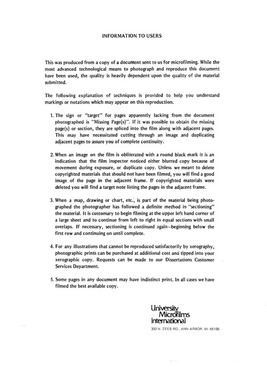| dc.contributor.author | Lee, Tae Jong, | en_US |
| dc.date.accessioned | 2013-08-16T12:28:24Z | |
| dc.date.available | 2013-08-16T12:28:24Z | |
| dc.date.issued | 1981 | en_US |
| dc.identifier.uri | https://hdl.handle.net/11244/4898 | |
| dc.description.abstract | The conformal solution method is used as the basis for developing mixing rules for the characteristic parameters appearing in a three-parameter, corresponding-states correlation of thermodynamic properties. A logical extension of the van der Waals (VDW) one-fluid rules from two to three parameters, referred to herein as the modified VDW one-fluid mixing rules, is shown to yield accurate predictions of vapor-liquid equilibrium (VLE) for binary mixtures of paraffin hydrocarbons with similar size molecules but poor VLE predictions for mixtures of paraffin hydrocarbons with highly dissimilar molecular sizes. Therefore, semiempirical exponent mixing rules were developed to obtain improved VLE predictive capability. In order to predict unlike interaction parameters from the characteristic properties of pure components alone, new correlations were formulated. The semiempirical exponent mixing rules, in conjunction with the correlations developed herein for unlike interaction parameters, gave predicted VLE accuracy standing about in the middle between the modified VDW one-fluid and semiempirical exponent mixing rules using individual unlike interaction parameters for each pair of paraffin hydrocarbons. The overall average absolute deviation of predicted methane K-values from experimental binary mixture data for methane with heavier normal paraffin hydrocarbons ranging from ethane through normal decane was 4.1% using the semiempirical exponent mixing rules compared with 11.0% for the modified VDW one-fluid rules (both using individual unlike interaction parameters for each fluid pair) and 7.78% for the semiempirical exponent mixing rules using the correlations for unlike interaction parameters. The three methods provide accurate predictions of bulk properties for the methane binaries. When tested for other light hydrocarbons and natural gas mixtures, the semiempirical exponent mixing rules show significantly better accuracy for VLE predictions for multicomponent mixtures involving light hydrocarbons, slightly better accuracy for binary mixtures involving light hydrocarbons and nitrogen and comparable accuracy for binary and multicomponent mixtures containing hydrogen sulfide and carbon dioxide (when compared to the modified VDW one-fluid mixing rules). Both mixing rules exhibit reasonably accurate predictions of VLE and bulk properties for these systems. The semiempirical exponent mixing rules with the correlations for unlike interaction parameters yield acceptable predictions of VLE and bulk properties for all mixtures studied except the hydrogen sulfide-carbon dioxide and ethane-ethylene systems. | en_US |
| dc.format.extent | xii, 137 leaves : | en_US |
| dc.subject | Engineering, Chemical. | en_US |
| dc.title | Mixing rules and unlike interaction parameter correlations for characterization parameters in a three-parameter corresponding-states thermodynamic properties correlation. | en_US |
| dc.type | Thesis | en_US |
| dc.thesis.degree | Ph.D. | en_US |
| dc.thesis.degreeDiscipline | School of Chemical, Biological and Materials Engineering | en_US |
| dc.note | Source: Dissertation Abstracts International, Volume: 42-07, Section: B, page: 2920. | en_US |
| ou.identifier | (UMI)AAI8129414 | en_US |
| ou.group | College of Engineering::School of Chemical, Biological and Materials Engineering | |
